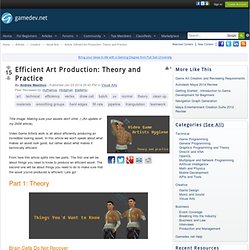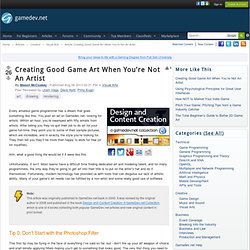

Low Poly Illustration, What's the Secret? Low Poly was a technique originally used for making 3D models and scenes for videogames, due to its render speed, which was achieved thanks to low polygonal resolution.

We recently published a post about the “Geo a Day” project, which uses this precise technique. To produce this kind of illustration, you can use basically any 3D software, but Cinema 4D is widely used because of its versatility and simplicity when it comes to modelling, lighting and visual effects, whereas other tools such as Maya or 3ds Max present a much steeper learning curve. Cinema 4D for absolute beginners Actually, this kind of scene is very easy to create compared with architectural visualization, photorealistic renders or any animation techniques.
You don't need a lot of experience modelling or understanding cameras and materials. Create your own Low Poly Illustration Inspirational Gallery. Efficient Art Production: Theory and Practice - Visual Arts. Title image: Making sure your assets don't stink :) (An update of my 2009 article).

Video Game Artists work is all about efficiently producing an incredible looking asset. In this article we won't speak about what makes an asset look good, but rather about what makes it technically efficient. From here this article splits into two parts. The first one will be about things you need to know to produce an efficient asset. The second one will be about things you need to do to make sure that the asset you've produced is efficient. Brain Cells Do Not Recover Even though most of the information to follow is about making your assets more engine friendly, please don't forget that this is just an insight into how things work, a guideline to know which side to approach your work from.
Dimension 1: Vertex Remember geometry for a second. I'm pretty sure most of you are used to receiving a triangle count as a main guideline for creating a 3D model. But that's the human way of thinking. Vertex VS Pixel. Creating Good Game Art When You’re Not An Artist - Visual Arts. Every amateur game programmer has a dream that goes something like this: You post an ad on Gamedev.net, looking for artists.

Within an hour, you’re swamped with fifty emails from artists. After telling you they’ve quit their job to do art for your game full-time, they point you to some of their sample pictures, which are incredible, and in exactly the style you’re looking for. They then tell you they’ll be more than happy to work for free (or for royalties). Ahh, what a good thing life would be if it were like this. Unfortunately, it isn’t. Note: This article was originally published to GameDev.net back in 2000. Tip 0: Don’t Start with the Photoshop Filter This first tip may be flying in the face of everything I’ve said so far, but - don’t fire up your art weapon of choice and start blindly applying filters hoping you’ll get to something that looks good.
The reason for this is that art, like anything else, is something you can get better at with practice. Also – learn art. Tip 1: Hide It. Efficient Art Production: Theory and Practice - Visual Arts. Ditching Diffuse Maps - Visual Arts. One of the most amazing things for me as an artist that current generation brought with it was the introduction of the concept of shaders.

No longer did we describe surfaces merely by flat images that already incorporated the majority of the lighting. Our materials became vastly richer with much more dynamic per-pixel lighting as well, and hands down had the biggest impact on the visual definition of the current generation of real-time graphics. But the programmable pixel and vertex pipelines were capable of much more than just calculating normal map and specular contributions.
Also that wide array of things you could do with a pixel was now at the fingertips of a much broader audience, including the visual content creators themselves, who finally got a chance to become the architects of their own tech. But such advancements came at a price: Productional: The amount and sophistication of content skyrocketed. How so? Still frame from my “Analyzing Beauty” Lecture, image by Zhu Haibo Damage.
Ryan Hawkins on Gumroad. Blizzard Style Textures.